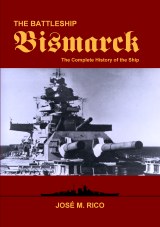 |
| Home Intro Technical History Crew Models Gallery Kriegsmarine Archives More Forum Español UPDATES |
Article Dealing with the Sinking of H.M.S. Hood as Witnessed from Cruiser Prinz Eugen
Die Vernichtung des "Hood"
The Annihilation of the "Hood"
Ein Augenzeugenbericht von der Begegnung zwischen "Bismarck" und "Hood" am 24. Mai 1941
An eye-witness report of the encounter between the "Bismarck" and the "Hood" on 24 May 1941
von
Leutnant (S) I.C. Schmitz (Kriegsmaler) Kriegsberichter
I.C. Schmitz, der dem Verband der Kampfgruppe "Bismarck" angehörte - und von
dem unsere drei Farbskizzen vom Gefecht zwischen der "Bismarck" und dem "Hood"
stammen -, hat uns seine Aufzeichnungen zur Verfügung gestellt, aus denen
wir den nachfolgenden Auszug über das Gefecht wiedergeben. 23 Mai: Vortoß inden Nordatlantik!
Die Zerstörer sind entlassen. Ich habe eine Aquarellskizze
unseres Verbandes von der Admiralsbrücke aus gemalt. Die See ist bewegt. Wundervoll
die klar-grüne Hecksee der "Bismarck" gegen die bleigrauen und violetten Farben
des Wassers. Die Schiffe sind gleichmäßig grau. Nachmittags 17.15 Uhr:
Erst eine, dann zwei Rauchfahnen achteraus. Die eine gehört einem Kreuzer
der London-Klasse. Um 19 Uhr feuert "Bismarck"
hart an uns vorbei: drei Salven auf den Gegner! Die Rauchwolke verschwindet
hinter dem Horizont. Trotzdem dauerndes Fühlungshalten. Es wird eine sehr
unruhige Nacht. Und dann der 24 Mai. Morgens 4.45 Uhr Alarm!
Ziel in 294 Grad, Entfernung 258 hundert. 4.50 Uhr stand das Ziel in 170 Grad,
233 hundert, 4.52 Uhr: Klar Schiff! Neuer Gegner an Backbord
in Sicht! 4.54 Uhr: Feuererlaubnis, 4.55 Uhr: Schwere Artillerie klar! Gleichzeitig
mit Feuerbeginn von "Hood" erste Salve "Bismarck". 4.57: unsere erste Salve.
4.58 Uhr: erster Treffer auf "Hood". 5.02 Uhr: "Hood explodiert und sinkt.
5.09 Uhr: Feuer einstellen!
So sah
es der Kriegsmaler, so sahen as alle. Während des Feuerduells zwischen
dem deutschen Schlachtschiff "Bismarck" und dem größen Kriegschiff der Welt
"Hood" entstanden die Blätter, die "Signal" hier veröffentlicht. Nach der
Schlacht legte Kriegsmaler Schmitz seine eben enstandenen Arbeiten dem Kommandanten
eines deutschen Kriegsschiffes vor, das dem Kampf und dem dramatischen Untergang
beigewohnt hatte. Der Kommandant bestätigte dem Maler, daß er die Phasen des
Kampfes naturgetreu wiedergegeben hat. Zu diesem Bild sagte der Kommandant:
"Die Explosion auf Hood ist sehr naturgetreu dargestellt. Ich persönlich habe
sie genau so beobachtet."
This is how the combat illustrator saw it, how we
all saw it. These sheets of illustrations,
which are published here by "Signal", were created during the actual firing
duel between the German battleship "Bismarck" and the largest warship in the
world, the "Hood". After the battle, the combat illustrator Schmitz presented
his just completed work to the commander of a German warship [Prinz Eugen] which was present
in the battle and the dramatic sinking. The commander [Kapitän zur See Brinkmann] confirmed for the painter
that he had depicted the phases of the battle in a life-like manner. The commander
said the following about this picture: "The explosion aboard Hood is depicted
very life-like. Exactly how I personally observed it."
Die handschriftlichen
Bemerkungen des deutschen Kriegschiff-Kommandanten auf den Farbskizzen des
Kriegsmalers lauten: "Das Schlachtschiff der "King George"-Klasse zieht sich
am sinkenden "Hood" vorbei. Das weit aus dem Wasser ragende Vorschiff habe
ich ebenso vermerkt. Es war schaurig schön".
The handwritten comments that the commander of the
German warship [Prinz Eugen] has made on the colour sketches are as follows:
"The battleship of the "King George" class passes the sinking "Hood". I also
observed the bow section projected far from the water. It was an eerily beautiful
sight."
"In diesem
Bild ist der Abschuß einer Vollsalve des Schlachtschiffes "Bismarck" mit dem
Widerschein auf dem abziehenden Qualm der vorherigen Salve überzeugend dargestellt.
Einschläge von solcher Höhe (siehe rechts) wurden reichlich beobachtet."
"This picture depicts convincingly the firing of
a full salvo by the battleship "Bismarck", showing the salvo's reflection
on the drifting smoke of the previous salvo. Impact columns of such height (on the right side) were frequently observed."
1937, in Malta, sah ich
"Hood" zum ersten Male, er war noch mit den Kennfarben der internationalen
Kontrollkommission bemalt. Mit großen Goldbuchstaben steht der Name an der
Achterkante seines Aufbaudecks. Irgend etwas am Vormars ist blau gestrichen,
so erinnere ich mich. Wie winzig klein sahen die Verkehrsboote und Pinassen
gegen ihn aus, die längsseits lagen, wie schmächtig der Zerstörer vom Typ
Campbell, Douglas. Als einziger Landsmann lag die "Stolzenfels" von der Bremer
Hanse im Hafen. Und jetzt der 24. Mai
1941. Was für ein seltsames Gefühl war das doch, als das, was seit ein paar
Tagen nur eine Rauchwolke hinten überm Horizont war, zu Masten wurde und dann
zu ein , zwei Schornsteinen mit gewaltigen Aufbauten davor. "Barham" sagte
Kuhlberg, unser Bordflieger, und auch ich, und als dann die weißen Wassersäulen
der Einschläge um unser Schiff standen, da meinten wir stolz: "Klar, denn
das sind doch keine Fünfzehner-Aufschläge!" Ein anderer meinte: "Der scheint
sich ja mächtig stark vorzukommen!" Und dann orgelt es wieder heran, brummt
dreimal über uns auf, wächst hoch, immer höher, und dann heißt es mit einmal:
"Prince of Wales", oder sind es zwei? "Hood" und "Prince of Wales"? "Na ja,
die am E-Messer haben ja bessere Augen als wir." Dann, nach dem fahlen
Aufblitzen des Mündungsfeuers drüben, mit einemmal Feuerschein: Das sind wir
gewesen! Muß in der Flugzeughalle gesessen haben! Auch der andere qualmt schwarz,
ihn hat es also ebenfalls erwischt. Und dann wieder bei Nummer eins, bei dem
"Hood", und da ist es, als hielte alles den Atem an, und man hört mit einemmal
wieder die Bugwelle rauschen. Dann aber dröhnt und donnert es von drüben herüber.
Drüben muß die Hölle los sein. Der "Hood" explodiert. Und aus dieser schweren
Silhouette des Schlachtschiffes ist eine grauenhaft lange Rauchbank geworden,
in der es kreisförmig quirlt, und die durchsetzt ist von kleinen aufblitzenden
Punkten. Das kreist und quirlt, und blitzt und ist gar nicht so dunkelbraun
oder schwefelgelb, wie man sich das so vorstellt, sondern ein entsetzliches
helles Aschgrau. Und der Eindruck dieses gräßlichen Grau sitzt fest, und der
ist geblieben bis heute. Und er is gleich wieder da, immer, wenn man die Augen
dichtmacht. Und so schnell da drüben dieses gigantische Vernichtungswerk gegangen
ist, wenn man nachher die kurzen knappen Zahlen nachrechnet; so im tatsächlichen
Eindruck hat es doch gespenstisch lange gedauert. Ebenso der dumpfe Donner,
hart überm Horizont, wie ein fernes Gewitter gegen die grellen Abschüsse unserer
Türme. 170 hundert hatten die E-Messer zuletzt gemessen, dann bricht es aus
dieser Qualmbank heraus - rot, orange, blutend, schweflig bis hoch hinauf,
und ich muß mit dem Glas folgen und kann es so schnell doch nicht erfassen,
denn in der Mitte, diese Hölle, die bannt den Blick immer wieder zurück, und
die Augen staunen, und die Seele erzittert vor dieser unendlichen Parabel,
die von der Glut gebildet ist. Das Glas fährt wieder hoch, den oben in dem
lichten graubraunen Wipfel, rot gefärbt an den Rändern, da oben ist auch wieder
dieses Quirlen und Aufblitzen. Auf der Nummer zwo, dem "Prince of Wales",
wachsen auch wieder ein paar Aufschläge hoch, sich scharf abhebend von dem
blauschwarzen Rauchgrund da drüben, und da höre ich mich mit einem Male brüllen,
und die Kameraden, die Signalgäste um uns brüllen auch, und wir sind heiser
noch Tage nachher. "Die haben noch geschossen, als sie hochgingen!" heißt
es. Und durchgegeben wird: "Der erste Gegner ist explodiert, der zwote brennt!"
Vier dramatische Minuten, vier Fotodokumente
By Lieutenant (S) J.C. Schmitz (combat artist)
The combat artist J.C. Schmitz [Julius C. Schmitz-Westerholt],
assigned to the battle group "Bismarck" - and from whom our three colour sketches
of the battle between "Bismarck" and "Hood" originated - has made his sketches
available to us. The following excerpt of the battle is based on these sketches.
23 May: Thrust into the North Atlantic! The destroyers
are released.
I have painted a watercolor sketch of our formation
as seen from the admiral's bridge. The sea is in motion. The sparkling-clear,
green wake of "Bismarck" contrasts wonderfully with lead-gray and violet colors
of the water. The ships are gray overall.
Afternoon at 1715 hours: First one, then two smoke trails
aft. One belongs to a cruiser of the London class.
At 1900 hours, "Bismarck" fires closely passed us: three
salvoes are shot at the opponent! The smoke trail disappears beyond the horizon.
Nevertheless, constant surveillance starts. It will be a very anxious night.
And then 24 May.
0445 AM. Alarm! Target at 294 degrees, distance 25,800
meters. 0450 target bearing at 170 degrees, 23,300 meters. 0452: Clear ship
for action!
New opponent sighted on port! 0454: Permission to fire.
0455: Heavy artillery ready and clear! Simultaneous commencement of fire by
"Hood" and first salvo from "Bismarck". 0457: our first salvo. 0458: first
hit on "Hood". 0502: "Hood" explodes and sinks. 0509: Cease fire! 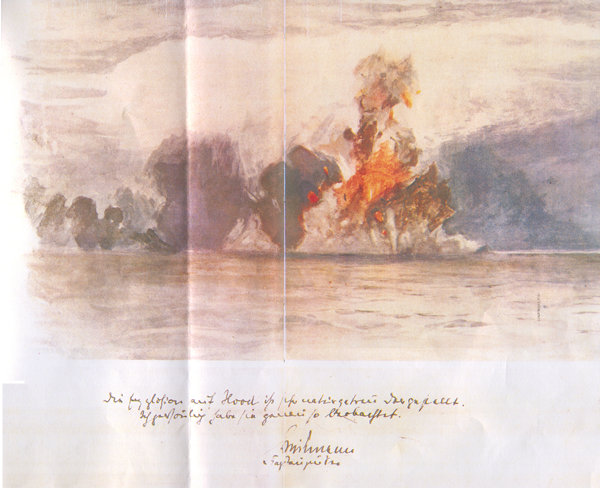
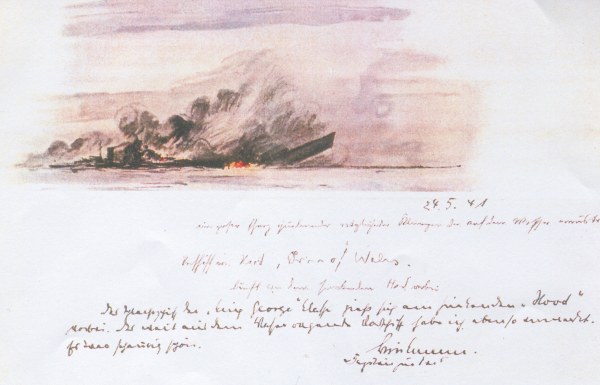
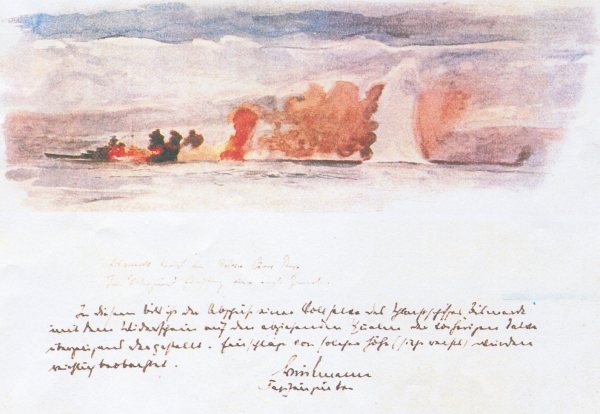
I saw "Hood" for the first time in 1937 at Malta, when
he was still painted with the identification colours of the international
commission. [a tricolor of wide red, white and blue stripes athwartships on
the B and X turret tops]. The name is attached in large gold letters at the
aft end of the superstructure on main deck. Something on the foretop is painted
blue, as far as I remember. The pinnaces and launches, which were alongside,
looked dwarfed by him [throughout "Hood" and "PoW" are referred to in the
male gender!] And how puny the destroyers of the Campbell and Douglas types
looked. A single countryman, the "Stolzenfels" [7,500 t of the Deutsche Dampfschifffahrts-Gesellschaft]
"Hansa" - Bremen, was moored in the harbor. [later converted to blockade breaker
and sunk by a British mine off Helgoland in 1941].
And now it is 24 May 1941. It is a strange feeling,
when something that was a mere smoke trail beyond the horizon a day ago, becomes
two masts, then two funnels behind an enormous superstructure. "Barham" says
Kuhlberg, our aircraft pilot, and when the white columns of water from the
impacts rose all around the ship, we boasted haughtily: "Obviously, these
are not 15 inch impacts!" Another, however, observed coolly: "He must delude
himself as being quite powerful!" And then the organ music starts anew, buzzing
thrice across us, and the columns rise higher and higher. And suddenly it
is clear that this is indeed the "Prince of Wales" himself, or are there two?
"Hood" and "Prince of Wales"? "Okay, okay, the rangefinder guys have better
eyes than us."
Then, after the pale flash of the muzzle fire from across,
there is a sudden bright glare of fire: We caused that! We must have hit the
hangar! The other one is also making black smoke, so he was also struck. And
then back to number one, the Hood, and there it is, as if everyone held their
breath, and once again one can hear the sound of the crashing bow wave. But
then booming and thundering comes across from over there. Hell must have broken
loose over there. "Hood" explodes.
And the powerful silhouette of the battleship has become
a gruesome long curtain of smoke swirling in a circular motion, accompanied
by small flashes. It rotates and swirls and sparks, and it is not as dark
brown and sulphur-yellow as one would imagine. By contrast, it is a sinister
bright ash-gray. And the impression that this ugly gray made, is still with
me today. And it readily reappears, if one closes one's eyes. This gigantic
act of destruction transpired quite rapidly, when one later reworks the actual
numbers; however, the real impression is that it lasted an eerily long time.
The same is true for the dull thunder, on the edge of the horizon, that reverberates
like a far-off thunderstorm against the blinding shots from our turrets. At
the end, the rangefinders were measuring 17,000 meters; then, it bursts from
the bank of smoke high into the sky in red, orange, blood-coloured and sulphurous
yellow. I have to follow it with my field glass, but I cannot believe it all.
The center of this hell defies observation, the eyes are staring in disbelieve,
and the soul is trembling at the view of this infinitely hellish parable that
is created by this inferno. My glass rises up higher again, because up there
at the gray-brown peak of the smoke column with its red-trimmed edges, up
there is more whirling and flashing. Aboard "number two", the "Prince of Wales"
some more water columns of the impacts rise up high, sharply outlined against
the blue-black background of smoke. And now I hear myself screaming, and the
comrades and signal crewmen about us also scream, and we were hoarse for days:
"They were still shooting at us as they were blowing up!" An announcement
is made: "The first opponent exploded, the second is on fire!"
Four dramatic minutes, four photographic documents
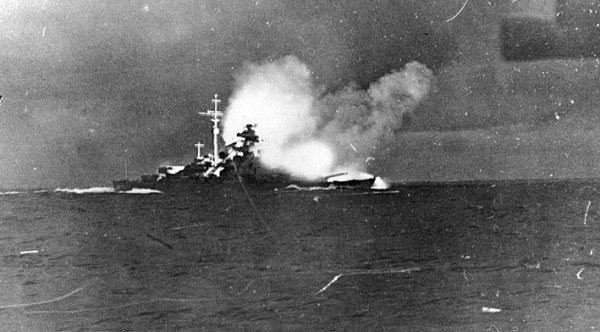
4.58 Uhr: Die "Bismarck", hell beleuchtet vom Schein des Mündungsfeuers ihrer eigenen Geschütztürme, im Duell mit dem "Hood". Die englischen Schiffe sind hinter dem Pulverdampf verborgen.
0458: The "Bismarck", brightly lighted by the flash of the muzzle fire of its own turrets, in a duel with the "Hood". The English ships are hidden by the powder vapour. 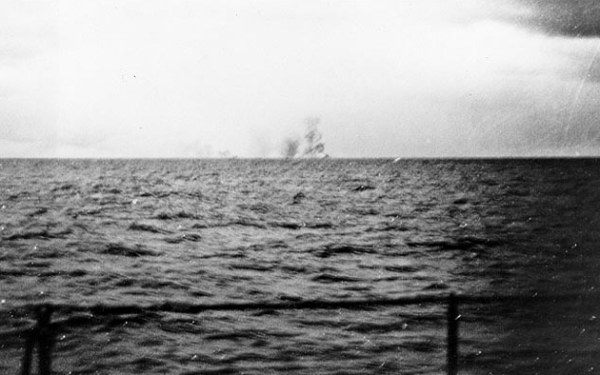
5.02 Uhr: Der "Hood" hat die entscheidenden Treffer bekommen und explodiert.
Links von ihm: Auch der "Prince of Wales" muß schwere Treffer einstecken.
0502: The "Hood" has received the decisive impacts and explodes. Left of him: "Prince of Wales" must also absorb heavy hits. 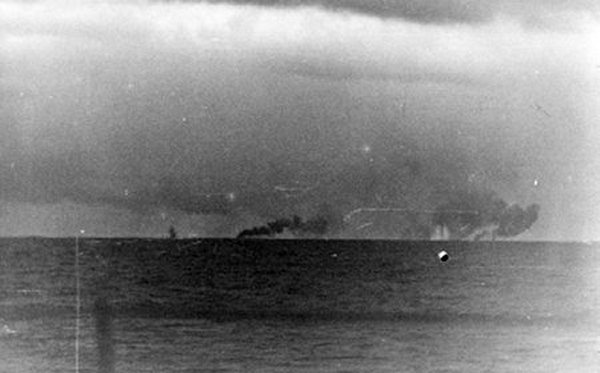
5.04: Noch ein Treffer auf den "Hood", Die beiden Wasserfontänen vor dem explodierten
Schiff rühren von Schüssen her, die zu kurz gesessen. "Prince of Wales" hat
die Entfernung zwischen sich und dem "Hood" vergrößert.
Unten: 5.08: Der "Hood" ist gesunken, "Bismarck" hat ihr Ziel gegen "Prince
of Wales" gerichtet. Vor dem deutschen Schlachtschiff liegt eine ungeheuer
große Rauchwolke, die von den Salven der "Bismarck" sind.
0504: One more hit for the "Hood". Both of the water
spouts in front of the exploding ship are from shells that fell short. "Prince
of Wales" has enlarged the distance between "Hood" and himself.
Below: 0508:
The "Hood" has sunk. "Bismarck" has changed her target to the "Prince of Wales".
Ahead of the German battleship lies an immensely large cloud of smoke that
is from "Bismarcks" salvoes. 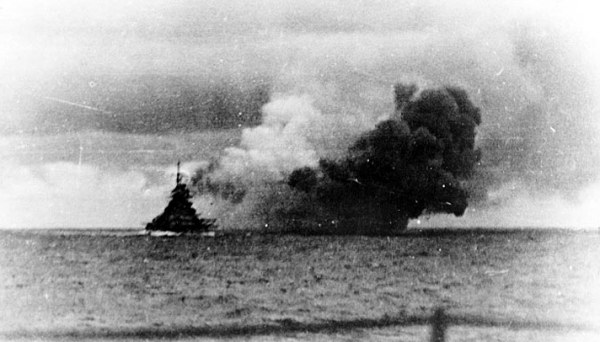

| Home Guestbook Quiz Glossary Help us Weights & Measures Video Credits Links Contact |
